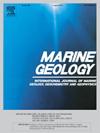Drilling the New Jersey shallow shelf to evaluate Miocene continental margin sequences, sea level, and resources
IF 2.2
3区 地球科学
Q2 GEOSCIENCES, MULTIDISCIPLINARY
引用次数: 0
Abstract
We review scientific ocean drilling of the New Jersey passive continental margin and the success of Integrated Ocean Drilling Program (IODP1) Expedition 313 in addressing long-standing, fundamental issues of sequence stratigraphy, sea-level change, and resources. The New Jersey margin was targeted for study by several generations of ocean drilling because of its thick, prograding Oligocene to Quaternary sequences bounded by unconformities. Coring and logging on the onshore coastal plain (Ocean Drilling Program [ODP] Legs 150Xhttp://www-odp.tamu.edu/publications/citations/cite150X.html and 174AX), outer continental shelf (Leg 174A), and continental slope and rise (Legs 95, 150, and 174A) provided a chronology of sea-level lowerings but did not sample facies needed to evaluate Miocene sea-level amplitudes. Expedition 313 used a Mission Specific Platform (L/B Kayd) to drill on the shallow continental shelf, recover critical Miocene facies, particularly on clinoform foresets, and capture the full amplitudes of relative sea-level changes. Expedition 313 overcame challenging borehole conditions and recovered a total of 1311 m of core at three sites (81 % recovery) that:
- (1)correlated difficult-to-date nearshore-shelf facies to the time scale with resolution better than ±0.5 million years (Myr);
- (2)tested and confirmed that sequence boundaries are a primary cause of seismic reflections on siliciclastic shelves;
- (3)tested sequence stratigraphic models with core-log-seismic integration; and.
- (4)provided a record of paleodepth changes through time that constrained amplitudes of Miocene sea-level change, including the influence of mantle dynamic topography. The New Jersey relative sea-level estimates are similar to those obtained using stable isotopes and Mg/Ca paleothermometry, showing that GMGSL (“eustasy”) varied with 10–60 m scale amplitudes on the Myr scale.
Drilling beneath the shallow continental shelf also identified groundwater sources, including seawater, deep-sourced brines, and meteoric fresh water, that represent potential resources for future generations. Studies of this margin have implications for future subsurface storage of supercritical CO2 and geotechnical issues relating to the location of offshore wind infrastructure. Expedition 313 demonstrated the feasibility of continuously recovering and logging strata in shallow water, providing constraints on sea level, sequences, hydrogeology, and resources.
钻探新泽西浅陆架以评估中新世大陆边缘层序、海平面和资源
我们回顾了新泽西被动大陆边缘的科学海洋钻探,以及综合海洋钻探计划(IODP1)第313远征队在解决长期存在的层序地层学、海平面变化和资源等基本问题方面的成功。由于新泽西州边缘具有厚的渐新世至第四纪的不整合层序,因此成为几代海洋钻探研究的目标。在陆上海岸平原(Ocean Drilling Program [ODP] Leg 150 × /www-odp.tamu.edu/publications/citations/cite150X.html和174AX)、外大陆架(Leg 174A)和大陆斜坡和隆起(Leg 95、150和174A)进行的取芯和测井提供了海平面下降的年代学,但没有提供评估中新世海平面振幅所需的样品相。313探险队使用任务专用平台(L/B Kayd)在浅层大陆架上进行钻探,恢复了中新世的关键相,特别是斜形前陆,并捕获了相对海平面变化的完整幅度。远征313克服了极具挑战性的钻孔条件,在三个地点共回收了1311米的岩心(回收率为81%):(1)将难以确定日期的近岸陆架相与时间尺度相关联,分辨率优于±50万年(Myr);(2)测试并确认层序边界是硅塑性陆架地震反射的主要原因;(3)用岩心-测井-地震一体化测试层序地层模型;(4)提供了限制中新世海平面变化幅度的古深度随时间变化的记录,包括地幔动力地形的影响。新泽西州的相对海平面估计值与使用稳定同位素和Mg/Ca古测温仪获得的估计值相似,表明GMGSL(“eustasy”)在Myr尺度上以10-60 m尺度振幅变化。在浅层大陆架下的钻探还发现了地下水资源,包括海水、深源盐水和大气淡水,这些都是子孙后代的潜在资源。对这一边际的研究对未来超临界二氧化碳的地下储存和与海上风力基础设施位置有关的岩土工程问题具有重要意义。考察313证明了在浅水中连续恢复和测井地层的可行性,提供了海平面、层序、水文地质和资源的约束条件。
本文章由计算机程序翻译,如有差异,请以英文原文为准。
求助全文
约1分钟内获得全文
求助全文
来源期刊

Marine Geology
地学-地球科学综合
CiteScore
6.10
自引率
6.90%
发文量
175
审稿时长
21.9 weeks
期刊介绍:
Marine Geology is the premier international journal on marine geological processes in the broadest sense. We seek papers that are comprehensive, interdisciplinary and synthetic that will be lasting contributions to the field. Although most papers are based on regional studies, they must demonstrate new findings of international significance. We accept papers on subjects as diverse as seafloor hydrothermal systems, beach dynamics, early diagenesis, microbiological studies in sediments, palaeoclimate studies and geophysical studies of the seabed. We encourage papers that address emerging new fields, for example the influence of anthropogenic processes on coastal/marine geology and coastal/marine geoarchaeology. We insist that the papers are concerned with the marine realm and that they deal with geology: with rocks, sediments, and physical and chemical processes affecting them. Papers should address scientific hypotheses: highly descriptive data compilations or papers that deal only with marine management and risk assessment should be submitted to other journals. Papers on laboratory or modelling studies must demonstrate direct relevance to marine processes or deposits. The primary criteria for acceptance of papers is that the science is of high quality, novel, significant, and of broad international interest.
 求助内容:
求助内容: 应助结果提醒方式:
应助结果提醒方式:


